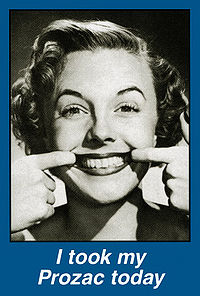Introduction to Psychiatry
Psychiatry is the treatment of patients with poor mental health, as opposed to the rest of medicine, which focuses on physical health.
A key perspective is understanding that mental health must be assessed in the context of social norms and whether the perceived 'problem' is not just a part of somebody's personality. Intervention is only necessary when normal social function is being negatively affected.
ICD-10
In the UK, and a fair few other countries, classification is based on the ICD-10 framework. In the USA, they use DSM IV, which is similar to ICD in many respects. Both are a classification system for all disorders of health: under ICD-10, mental health disorders are in the F category[1].
There are 4 digits, with the last optional, so, for example:
- F31 is Bipolar affective disorder
- F31.4 is Bipolar affective disorder, current episode severe depression without psychotic symptoms.
Key disorders
There are four key areas of psychiatry: mood, schizophrenia, personality disorders and dementia. Whilst there are others, most of what you will deal with fall into these loose categories.
Mood and neurosis
The commonest of these is depression. You will almost certainly know a friend, relative or patient that suffers from this. Defined by a triad of symptoms: low mood, loss of energy, loss of interest. Most commonly treated with SSRI antidepressants and/or cognitive behavioural therapy.
There are a variety of anxiety disorders, however the commonest is generalised anxiety disorder; defined as a state of anxiety present most of the time without appropriate stressors. Shares a lot in common with depression, also treated with SSRIs and CBT.
Bipolar disorder is a mood disorder with both ends of the spectrum; low mood and innappropriately high mood - mania. Patients will often swing between the two levels over periods of weeks. When manic, they will often have pressured speech and grandiose or paranoid delusions. Usually they are treated with an atypical antipsychotic and a mood stabilizer.
Schizophrenia
Schizophrenia is the classic "hearing voices", mad-as-a-bag-of-squirrels psychiatric condition. It is characterised with ABCD as:
- Auditory hallucinations
- Broadcast thoughts
- Control delusions
- Delusionary beliefs
Can be difficult to manage, but usually atypical antipsychotics work. In some cases of resistant conditions, clozapine is used. This needs monitoring, since it can cause agranulocytosis.
Personality disorders
Unlike most of psychriatic disorders, personality disorders are rarely treatable with medication. They fall into three clusters, known informally as mad, bad and sad:
- Mad - Includes paranoid and schizoid personality disorders, which often have fixed quasi-delusional beliefs, and odd isolation from society.
- Bad - This category includes borderline, or "emotionally unstable personality disorder", and dissocial personality disorder. These patients are manipulative and impulsive, prone to violent/threatening behaviour and self harm/suicide.
- Sad - With anxious, depressed and obsessive personalities in here, these patients find life a struggle, and need to learn coping strategies to overcome these traits. Or they go on to become anaesthetists[2]...
Common, especially in teenage girls, are the eating disorders; specifically anorexia nervosa and bulimia.
Dementia
In the UK, an ever growing field, since we have an ageing population. The commonest dementia is Alzheimer's, although its worth knowing about vascular dementia and Lewy body dementia too. No real treatments, although some drugs can have some positive effects in increasing functioning.
Other Psychiatric Disorders
Psychiatry affects people in all ages and walks of life. Commonly problems can occur in old age, pregnancy, childhood and amongst those abusing alcohol and other substances.
References
- ↑ ICD-10 Online Last accessed 02/03/2011
- ↑ "Personality traits of anaesthetists and physicians: an evaluation using the Cloninger Temperament and Character Inventory." M. T. Kluger, et al. Anaesthesia; Volume 54, Issue 10, pages 926–935, October 1999
